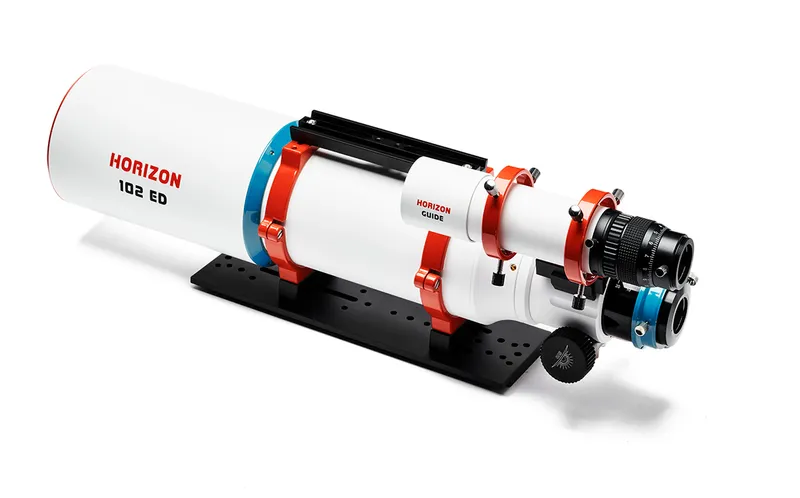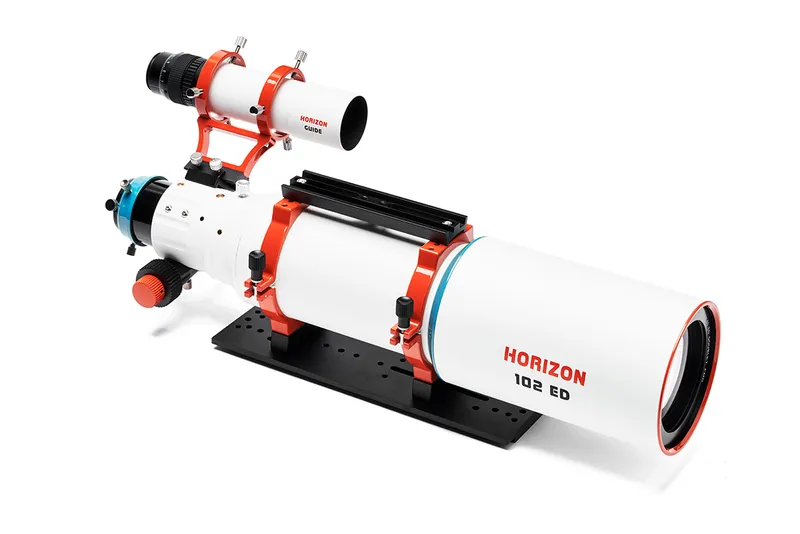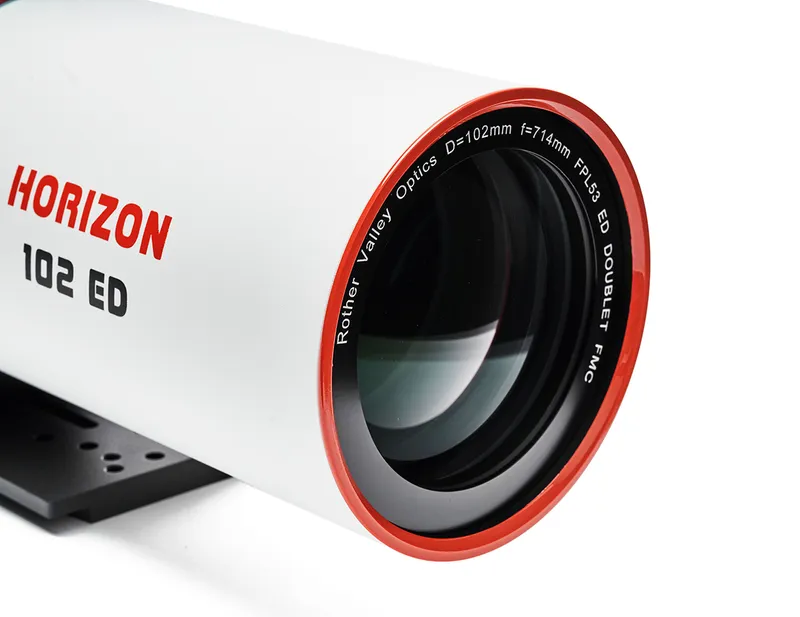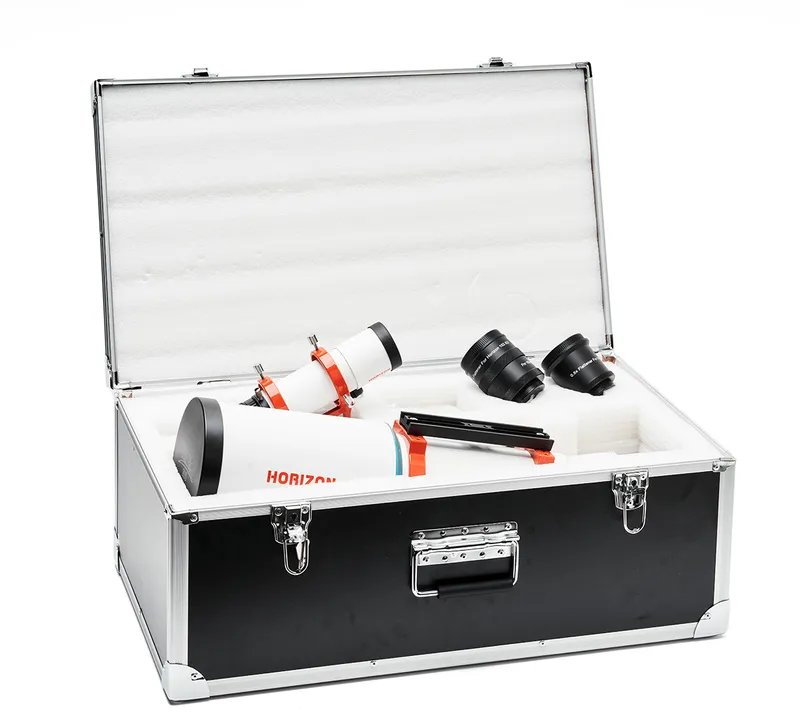The Horizon 102 ED Doublet is the latest addition to the Rother Valley Optics' (RVO) family of Horizon refractors, which includes the Horizon 60, 72 and 80 doublets.
It offers both the largest aperture and longest focal length of the series at 714mm, giving a focal ratio of f/7.
We received the standard Horizon 102 ED Doublet package (carry case and telescope with tube rings and bar), along with a suite of optional accessories to help with our test, including a finderscope, reducer/flattener and stand-alone field flattener.
Adorned with the smart-looking RVO Horizon logo, the Horizon 102 ED Doublet gave an excellent first impression, not least because of the unique blue, red and orange detailing on both the optical tube assembly (OTA)and matching optional 50mm guidescope.
A closer inspection confirmed excellent build quality, with not a hint of plastic in sight and all parts machined with an attractive brushed metal finish.
We made an early note of the Horizon 102 ED’s weight of 5.8kg without accessories
Unsurprisingly, given the substantial optics, this is not an OTA suitable for lightweight or star-tracker mounts.
With a CCD and finderscope attached, the total setup weighed 7.5kg, which, particularly for imaging, is more suited towards mounts with a payload of at least 15kg.
This member of the Horizon family is therefore likely to appeal to seasoned imagers who possess heavy mounts.
This telescope features in our guide to the best telescopes for observing the planets

Setting up the Horizon 102 ED Doublet
That isn’t to say that setting up the Horizon 102 ED for our visual and imaging test wasn’t a breeze
The substantial Losmandy bar supplied with the OTA made balancing on our pier-mounted Sky-Watcher EQ6-R quick and easy.
Our first clear night with the Horizon 102 ED coincided with an 80%-illuminated Moon and so, popping a star diagonal and eyepiece in, we swung over and enjoyed some lovely crater detail despite the glare.
A star test on a dark patch of sky confirmed that, even without the field flattener attached, we could enjoy round stars across the field of view with minimal colour distortion.
Indeed, the long focal length of 714mm lends this scope to planetary imaging, although sadly at the time of the review the ideal planets of Jupiter and Saturn were not available to image.
We found the quality of the focuser to be seriously impressive, placing the Horizon 102 ED well in front of the average OTA in its price bracket.
Not only were the large focus knobs easy to locate in low light, but the action was incredibly smooth and we experienced absolutely no play in the microfocus.
This allowed us to achieve pinpoint stars swiftly and easily, as the fine-tuning proved accurate.

We could already appreciate the large doublet as a visual refractor, but were keen to put it through its imaging paces.
A week later, we had clear skies and opted to try the flattener coupled with our CCD camera.
ttaching it was easy, as it is designed specifically for the OTA.
The required 55mm back focus was easily obtained and confirmed by a beautifully flat, consistent field of view.
Homing in on the Jellyfish Nebula, IC 443, we took 60 minutes of hydrogen-alpha and 45 minutes of OIII frames.
Despite damp nights, the front element remained clear even without a dew strap attached.
We also noted that the focus held securely in place while switching filters.
Later, post-processing in Photoshop confirmed round stars and minimal distortions.
A few nights later, we took advantage of another clear night to image the Monkey Head Nebula, NGC 2174, grabbing the same time again on each narrowband filter.
To sum up, the Horizon 102 ED proved an easy-to-use, robust refractor
The rotation adjuster allowed us to perfectly align our image without altering our focus, which – thanks to the Horizon 102 ED’s excellent focuser – was already perfect.

Horizon 102 ED Doublet's aperture
The 102mm aperture – relatively large for a refractor – places the Horizon 102 ED firmly in the heavyweight range, ensuring that as much light as possible hits the camera sensor and granting astrophotographers access to fainter, more delicate objects.
This glass, coupled with a focal length of 714mm, also means more detailed captures of popular Messier Catalogue and NGC classics.
The addition of the optional, specially designed 0.8x reducer/flattener provides a wider field of view should you wish to image larger objects.
Meanwhile, the FPL-53 glass is designed to limit chromatic aberration (such as colour fringing and halos) over legacy FPL-51 glass.
Rother Valley Optics bench-tests each OTA before delivery to ensure it meets the highest optical standards.
A summary of this test is included with each Horizon 102 ED.
The Horizon 102 ED’s aperture and focal length also make it suitable for lunar and planetary photography when coupled with a fast-frame-rate camera.

Horizon 102 ED Doublet best features
Mounting bar for finder/guidescope
The Horizon 102 ED comes ready-fitted with a suitable top-mounted Vixen bar for attaching a guidescope, along with a shoe for attaching other accessories such as a finderscope. Such equipment often requires the purchasing of compatible mounting hardware, so these are very useful extras supplied as standard.
Losmandy dovetail bar with tube rings
The supplied and fitted wide Losmandy dovetail bar measures 10cm across and 30cm long and
is perfect for this large refractor, providing for a more secure fitting suited to mid- to heavyweight mounts. It also gives plenty of length to balance the telescope with accessories and imaging equipment attached.
Retractable dew shield
Protected with a smart, metal cap that’s etched with the RVO Horizon logo, the 102 ED comes with
a 225mm dew shield. This can be fully retracted with the tube rings attached, which helps when storing back in the box. With the shield retracted, the OTA measures 600mm long, ensuring it remains relatively portable and manoeuvrable.
Rack and pinion focuser
The robust, dual-speed focuser with 10:1 microfocus is fully rotatable, allowing us to alter camera position without losing focus. It has a 2-inch barrel yet also comes with a 1.25-inch adaptor.
The tension adjuster and focus lock reduce the risk of slippage, while the annotated measurement scale is an excellent addition, allowing users to note focus positions.
Flight case with carry handle
The aluminium carry case is large enough to house the Horizon 102 ED with tube rings attached and is exceptionally well padded. There is also space to store other accessories including a finder/guidescope and a reducer or flattener, ensuring these can be kept with the OTA at all times.
Vital stats
- Price: £1,095
- Optics: Air-spaced FPL-53 ED doublet
- Aperture: 102mm
- Focal length: 714mm, f/7
- Focuser: 2-inch dual-speed rack and pinion
- Extras: Losmandy mounting bar, Vixen-style top accessories bar, aluminium flight case
- Weight: 5.8kg
- Supplier: Rother Valley Optics
- Tel: 01909 774521
- www.rothervalleyoptics.co.uk
This review originally appeared in the July 2023 issue of BBC Sky at Night Magazine.

